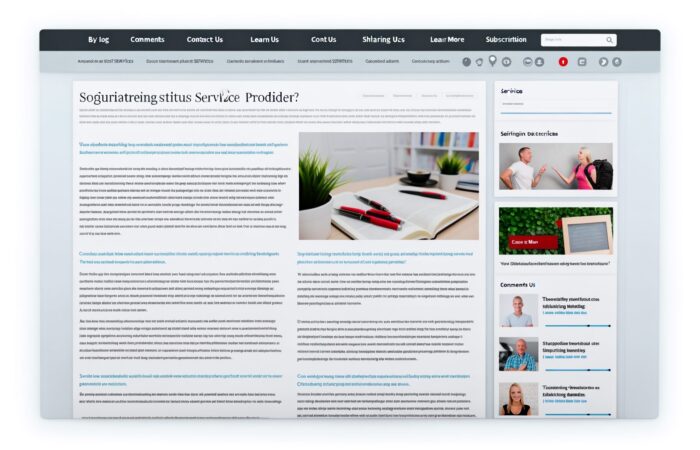Introduction to Case Studies and Their Impact on Conversions
If you’ve ever wondered whether those detailed case studies actually do anything for a business, you’re in the right place. Let’s dive into the world of case studies and explore how they can genuinely amplify conversions and boost business outcomes. It’s all about showing, not just telling, and a well-crafted case study does exactly that.
So, what exactly is a case study? In a nutshell, it’s a deep dive into how a product or service has successfully solved a problem for a customer. But it’s more than just a simple testimonial or a customer review; it’s a comprehensive showcase of a problem-solving journey. Think of it as a heroic story where the product is the hero!
Why Case Studies Matter?
Consider this: when you’re about to make a purchase, what convinces you more? Abstract features and benefits or seeing a real-life example of someone else’s experience? Most of us would lean toward the latter. That’s the magic of a case study. It provides proof and builds trust. Here are a few reasons why case studies can be a superpower for conversions:
- Relatability: Seeing a real person’s challenges and how they overcame them with a product or service makes it easier for potential customers to see themselves in the same situation.
- Proof of Concept: It’s one thing to claim your product can do something; it’s another to show it in action. Case studies provide that concrete evidence that what you’re offering really works.
- Authority: Publishing detailed case studies establishes you as an expert in your field. This kind of content contributes not only to direct sales but also to long-term brand credibility.
- Detailed Insight: Case studies provide a detailed view of the customer’s journey that simple statistics or testimonials might not be able to convey. This depth can help nudge those sitting on the fence.
But hey, it’s not just about throwing some numbers and stories into a document. The true effectiveness of a case study comes from its ability to engage and persuade. And yes, that means storytelling, visuals, data, and a good structure are all part of the mix – but more on those later.
Conversions? Yes, Please!
Imagine you’re a customer looking for a software tool. You come across two websites. One has a bunch of generic descriptions and a list of features. The other includes a detailed story about how they helped a business similar to yours double their revenue in six months. Which one are you likely to trust more? The second one, right? That’s where case studies shine. They don’t just attract eyeballs; they convert interest into action.
So, crafting compelling case studies can be a game changer for any business. They are like the secret sauce that spices up your marketing strategy, giving potential customers a taste of what’s possible. Ready to leverage the power of real-life success stories? Stay tuned as we uncover the essentials of selecting the right subject for your case study and structuring it to captivate your audience.
Remember, the goal is to not only attract potential customers but to turn them into happy, paying ones. And a great case study can be just the ticket to making that happen. Let’s make your case studies your conversion heroes!
Selecting the Right Subject for Your Case Study
So, you’re ready to dive into creating a case study that shows off your successes and makes your potential customers nod in approval? Great decision! The first step, and quite crucial, is selecting the right subject. This is like picking the main character for your favorite show – get it right, and your audience will be hooked!
Let’s chat about how you can pick a winning subject for your next case study.
Identify Your Goals
First things first: What do you want to achieve with this case study? Are you looking to showcase a particular product’s effectiveness? Perhaps you want to highlight your exemplary customer service. Identifying your goals early on helps you pinpoint the right subject that aligns with your objectives.
Know Your Audience
Ask yourself, who is my audience and what do they care about? Understanding your audience’s needs and pain points will guide you to select a subject that resonates with them. If you’re targeting small business owners, for example, they might be interested in efficiency and cost-saving solutions. Choose a client or a project that addresses these specific areas.
Find Your Best Success Stories
Got a customer who saw amazing results after using your product or service? That’s gold! Success stories are compelling because they provide tangible proof of what you’re capable of. Look for subjects where you have clear before and after data—this will make your case study more concrete and relatable.
Consider Variety
If you’ve already published a few case studies, think about diversifying. Showcasing a variety of different subjects, industries, or challenges makes your business look versatile and adaptable. This can attract a wider audience and keeps your content fresh and engaging.
Seek Unique Angles
Finding a subject that offers a unique angle or an unexpected success story can really capture the attention of your audience. Maybe your product solved a problem that it wasn’t initially designed to solve, or perhaps you helped a client overcome unusual odds. These unique stories stick in the mind more, making your case study stand out.
Collaboration is Key
Choosing a subject shouldn’t be a solo mission. Collaborate with your team, discuss potential options, and get various perspectives. Sometimes, a colleague might remember a perfect project that you hadn’t considered. Plus, involving your team can help ensure that the case study covers all aspects thoroughly.
A Quick Checklist:
- Clarify your goals for the case study.
- Analyze your audience’s interests and challenges.
- Scout for successful projects or happy customers.
- Consider a mix of industries or problems solved.
- Look for stories with a unique hook or angle.
- Involve your team in the selection process.
In selecting the right subject for your case study, you’re setting yourself up for a powerful piece of marketing that can attract, engage, and convert. Remember, the most effective case studies are both relatable and aspirational; they not only demonstrate what you’ve done but also inspire potential clients to think, “I want that success too!”
Now, off you go! Search through your accomplishments and pick a star player to feature in your next marketing win!
Structuring Your Case Study for Maximum Engagement
Ever wondered why some case studies keep you hooked while others just don’t stick? Well, it’s all in the structure. A well-structured case study is not just a joy to read, but it’s also an effective tool in driving the point home (or shall we say, driving conversions home?). Let’s dive into how you can structure your case study to keep your readers engaged and loving every bit of it!
The Golden Introduction
First things first, start with a bang! Your introduction should grab attention like a magnet. Set the stage by presenting the problem your customer was facing. But here’s the kicker – do it in a way that your readers can see themselves in your customer’s shoes. Make it relatable and reel them in to read more!
The Meaty Middle
Now, let’s get to the heart of your case study – the solution. Step-by-step, unfold the story of how your product or service came to the rescue. But hold on, don’t just tell them what you did. Show them how you did it:
- Challenges: Outline the obstacles you faced along the way. This adds a dash of reality and drama!
- Action Steps: Detail the actions you took. Be clear and concise, like a chef carefully explaining a recipe.
- Tools & Technologies: Mention any tools or tech you employed. This bit is especially loved by tech enthusiasts and industry peers.
The Triumphant Conclusion
As you draw towards the end, it’s time to unveil the results. This is where your case study shines. Highlight the outcomes and benefits of your solution, showcasing clear before-and-after comparisons if possible. And remember, numbers talk, so sprinkle some compelling stats to back up your success story.
Reflective Insights
Before you wrap up, share key insights or learnings that emerged from the experience. Reflecting on what you or your customer learned makes your case study more profound and insightful. It’s like leaving your reader with a savory piece of chocolate after a delightful meal – it just completes the experience.
Call-to-Action
And finally, don’t forget to end with a call-to-action. Encourage your readers to contact you, try your product, or simply learn more. It’s like saying, “Hey, if you loved this story and want a similar happy ending, here’s how you can get it!”
There you have it – a simple blueprint for structuring your case study that’s not just informative but also utterly engaging. With this framework, you’re all set to craft stories that not only illustrate your successes but also captivate your audience. Go on then, start crafting those engaging tales; your readers are waiting!
Incorporating Data and Statistics to Establish Credibility
If you’re keen on making your case studies not just good but great, you’ve got to sprinkle a bit of that special sauce – data and statistics. Now, I know what you might be thinking: “Data, uh, sounds boring.” But hear me out! Integrating hard numbers can transform your case studies from simple narratives into compelling, credibility-packed stories. Let me show you how to do this without turning your readers off.
Why Bother with Data?
First off, let’s get down to why data is such a big deal. It’s all about trust. When you present clear, concrete numbers, you’re not just telling your audience what you did; you’re showing them. It’s the difference between saying “Our solution helps save time!” and “Our solution helped Company X reduce their processing time by 30% in three months.” The latter, packed with specifics, makes people sit up and take notice.
Finding the Right Data
Okay, so you’re on board. But where do you find this data? Start with the results your product or service has achieved. Talk to your sales team, check out customer feedback, and dive into any performance metrics you have. The goal here is to find quantifiable impacts that your solutions have had. Think along the lines of percentage improvements, time saved, revenue increased, customer satisfaction scores — you get the gist.
- Customer Success Stories: Direct insights from customers can be gold. Did they see a bump in efficiency? How much did their engagement increase?
- Before and After Scenarios: Capture data showcasing the situation before and after your intervention. This contrast can highlight your impact starkly.
- Benchmark Reports: Use industry reports as a benchmark to illustrate how your solutions stack up against average outcomes or standards.
Making Data Digestible
Now that you’ve got your data, the trick is to present it in a way that’s easy to digest. Avoid overwhelming your audience with numbers cluttered everywhere. Instead:
- Use Visuals: Graphs, charts, and tables are fantastic for summarizing data succinctly. They help readers grasp complex information quickly without slogging through a sea of numbers.
- Highlight Key Figures: Sometimes, you just need to bold the most impressive stats to draw attention. It’s about making the big wins easy to spot.
- Keep it Simple: Stick to the most impactful stats that directly relate to your narrative. You don’t need to include every single number—just the ones that best tell your story.
Incorporating data into your case studies doesn’t have to be a chore or a bore. Done right, it lends authority and persuasiveness to your story, making it not only more credible but also more compelling. Remember, the goal here is not just to inform but also to convince and convert. By strategically using data, you give your case study the weight it needs to do just that effectively. So go ahead, give your case studies that extra edge with some number magic!
The Art of Storytelling in Case Studies
Let’s dive into one of the most captivating elements of creating case studies—storytelling. You see, storytelling isn’t just for books and movies. It’s a powerful tool that breathes life into your case studies, making complex information relatable and engaging for your audience. But how exactly do you accomplish this? Let’s explore together!
Why Storytelling?
First things first, why bother with storytelling in case studies? Well, stories have a unique way of connecting with people on an emotional level. They make your readers care, turning cold hard facts into compelling narratives. This emotional connection not only keeps your audience interested but also helps them remember your message long after they’ve finished reading.
Character Development
Every good story needs a protagonist your audience can root for. In the case of case studies, your protagonist is usually your client or customer. Start by setting the scene—describe who they are, what challenges they faced, and their goals. This builds a foundational connection and sets the stage for the transformation story.
Conflict and Resolution
No story is complete without a bit of drama. The conflict here involves the challenges or problems your protagonist faced. Be detailed—explain the stakes and why solving these issues was crucial. Then, lead into the resolution, showcasing how your product or service swooped in to save the day. Highlight the solutions provided and the expertise involved.
Emotional Pull
Don’t shy away from the emotional aspects of the story. Did your client feel overwhelmed? Hopeless? Excited? Integrating these emotions makes the journey more relatable. When you showcase the transformation from despair to delight, you’re not just selling a product; you’re offering a pathway to happiness.
The Climactic Success
Every story needs a victorious climax. This is where you reveal the successful outcomes of your intervention. Maybe it’s a dramatic increase in sales, improved customer satisfaction, or a technical problem solved. Use concrete results to paint a picture of success.
Keeping It Real
While it’s tempting to make your case study a tale of overwhelming success, it’s important to keep it real. Authenticity matters as readers can detect exaggeration. If there were setbacks along the way, share them and then emphasize how they were overcome. This not only boosts credibility but also shows potential clients that you’re prepared to handle challenges.
- Keep it relatable: Use simple language and relatable situations.
- Focus on outcomes: Highlight the practical benefits of your solution with real-world applications.
- Show, don’t tell: Use examples and anecdotes to demonstrate your points rather than just stating them.
Remember, the art of storytelling in case studies isn’t about creating the perfect narrative; it’s about making connections and leaving a lasting impression on your readers. So go ahead, tell a story that makes your audience feel, understand, and remember. You’ve got this!
Utilizing Visuals and Media to Enhance Your Message
Let’s chat about jazzing up your case studies with some snazzy visuals. You know, the kind that grab your readers’ attention and don’t let go. It’s like turning a plain old vanilla textbook into a cinematic experience!
Pictures Speak Louder Than Words
Ever glanced at a huge block of text and felt tired? Yep, we’ve all been there. That’s why integrating compelling images, infographics, or videos can transform your case study from bland to grand. Imagine showing a before-and-after snapshot of a client’s workspace – way more impactful than just describing it, right?
Choosing the Right Type of Visuals
- Charts and Graphs: Got data? Show it off with a chart or graph. These are perfect for making complex data accessible and digestible. Plus, they’re great at showing trends and comparisons at a glance.
- Infographics: Combine text and graphics to tell a story or explain a process step-by-step. These are super for conveying quick facts and figures while keeping the eye engaged.
- Photos and Videos: Real photos add a touch of authenticity, while videos hold attention like nothing else. Ever thought about a mini-documentary featuring your success stories? It could be a game-changer!
Integrating Visuals Seamlessly
It’s all about the flow. When adding any visual element, ask yourself, “Does this support my point?” If it does, great! But keep it balanced – visuals should enhance your story, not overshadow it. It’s like seasoning food; just the right amount will perfect a dish, but too much can spoil it.
Integrating visuals also means considering their placement. Sprinkle them throughout your case study to keep readers moving down the page. Imagine a reader’s journey through your case study as a trail of breadcrumbs made up of images, charts, and videos leading them to your conclusion.
Tools of the Trade
Don’t worry, you don’t need to be a graphic designer to create stunning visuals. Tools like Canva, Adobe Spark, or Piktochart are user-friendly and come loaded with templates specifically designed for non-designers. Plus, they’re fun to use!
Tips for the Perfect Visual Match
- Keep it relevant: Each visual should have a clear connection to the text it accompanies.
- Quality over quantity: Opt for high-quality images and polished graphics. Blurry or pixelated visuals can hurt your credibility.
- Consistency is key: Stick to a consistent style and color scheme throughout your visuals. This helps in maintaining a professional look.
There you have it! A mini-guide to making your case studies visually irresistible. Remember, the goal is to communicate your success story in the most engaging and effective way possible. With the right visuals, you’re not just sharing data; you’re telling a compelling story. Let’s make your case studies shine!
Best Practices for Promoting Your Case Studies
Let’s chat about spreading the word about your awesome case studies. After all that hard work of putting them together, you certainly want them seen, right? Promoting your case studies might sound daunting, but it’s really about being smart and engaging. Here are some must-do tips to help get your case studies the attention they deserve.
1. Leverage Your Website
The first pit stop for your case studies should be your own website. Create a dedicated section for case studies where visitors can easily find them. Spotlighting them on your homepage or a relevant product page can also drive interest and engagement.
2. Dive into Email Marketing
Email isn’t dead! In fact, it’s a golden way to get your case studies directly into the hands of interested readers. Segment your audience and send tailored case studies that match their interests or industry. This personal touch can significantly boost your engagement rates. Don’t forget a catchy subject line!
3. Utilize Social Media
It’s the age of social media — use it to your full advantage! Sharing snippets or intriguing findings from your case studies can pique curiosity and drive traffic to your website. Consider the variety of formats different platforms offer:
- Instagram: Use eye-catching images or short videos.
- LinkedIn: Perfect for B2B case studies, share them in professional groups or write posts linking back to your full study.
- Twitter: Great for quick, engaging stats or quotes from your case study.
Tag involved clients (with their permission) to broaden your audience reach.
4. Blog About It
Why not expand on your case study in a blog post? This gives you space to go deeper into the backstory, the challenges, solutions, and results. A well-written blog post that tells a compelling story can captivate readers and motivate them to explore the full case study. Plus, it’s good for SEO!
5. Give a Webinar or Podcast
Talk about engaging! Hosting a webinar or being a guest on a podcast can bring your case study to life. Discussing it verbally allows for detail and nuances that written text may not capture. It’s also a fantastic opportunity to answer live questions and directly engage with your audience.
6. Create Videos
Videos can transform your case studies into dynamic, easily digestible content. Whether it’s a full detailed story or a quick, engaging teaser, videos can be shared across many platforms including your website, YouTube, and social media.
7. Use Presentations at Conferences
If the opportunity arises, sharing your case studies at conferences or networking events can enormously amplify their impact. A compelling presentation can highlight your successes and provoke discussions, often leading to new professional connections and opportunities.
Remember, the key to successfully promoting your case studies is to be creative, persistent, and genuinely engaged with your audience. So, ready to get the word out? Your case studies just might be the game-changer someone needs to see today — let’s make sure they do!











No Comment! Be the first one.